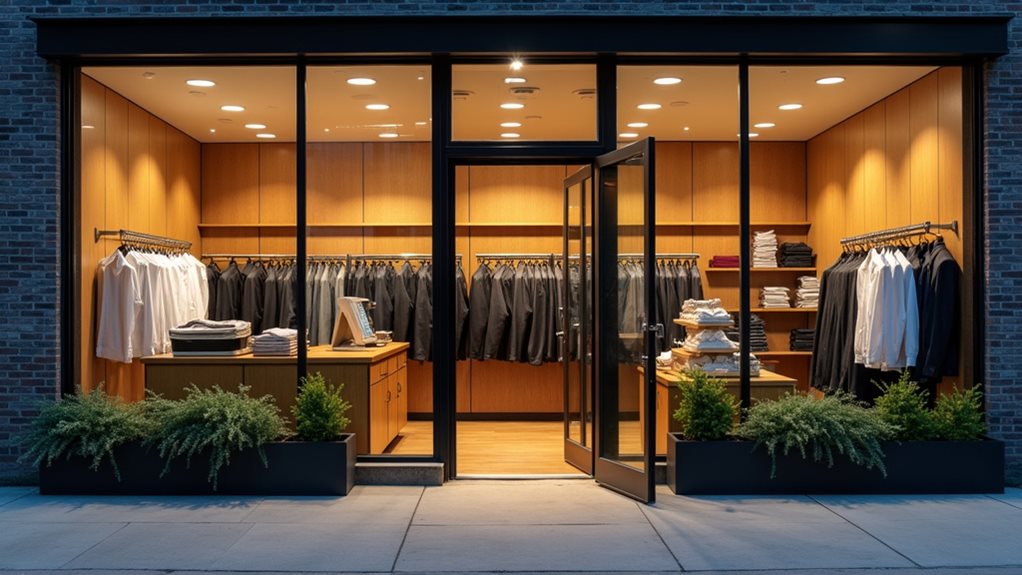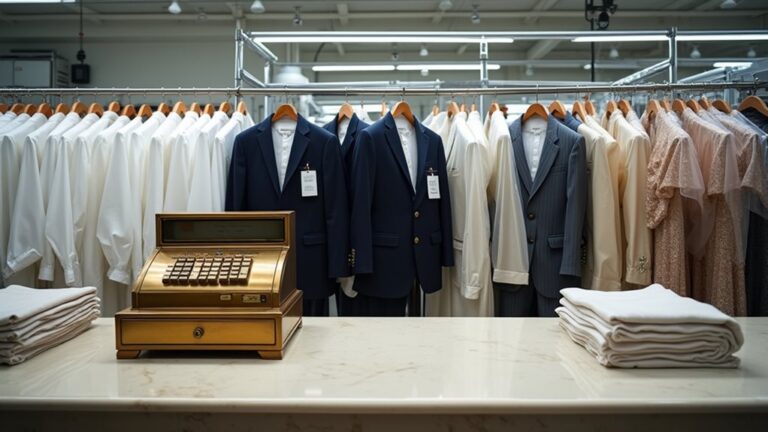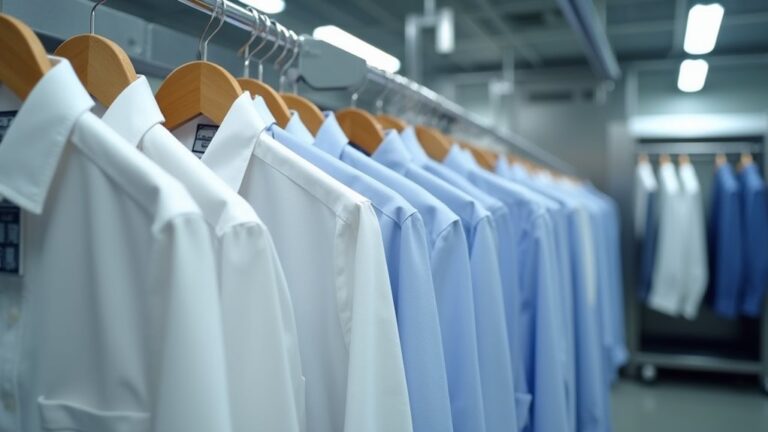Your dry cleaning business can earn anywhere from $24,000 annually in small towns to an impressive $360,000 in bustling metropolitan areas, though I’ve learned that location isn’t everything—your success really depends on how well you manage those sneaky operating expenses that typically run $40,000 to $70,000 yearly. With gross margins hovering around 30-50%, you’ll need to serve roughly 2,000 pieces monthly to break even, but the smartest operators I know focus on building loyal customer relationships and optimizing their pricing strategies to reveal the industry’s true earning potential.
Revenue Generation and Pricing Structure for Dry Cleaning Services
Three main revenue streams typically drive a dry cleaning business’s success, and understanding how to price each service appropriately can make the difference between barely scraping by and building a thriving operation that supports your family’s dreams.
Your bread-and-butter revenue streams come from basic items like shirts ($3-7), suits and dresses ($10-20), and specialty pieces like comforters ($15-30).
I’ve learned that those little add-ons—stain removal and extra pressing—can boost your profits by $2-5 per item, which honestly adds up faster than you’d think!
Smart operators also offer subscription packages for regular customers, creating predictable income while giving clients discounted rates.
Clear pricing displays help customers understand your dry cleaning services’ value, turning browsers into buyers.
Geographic location significantly impacts what you can charge, as urban markets typically support higher pricing than rural areas due to higher operating costs and customer demographics.
Customer Segmentation and Spending Patterns in the Dry Cleaning Industry
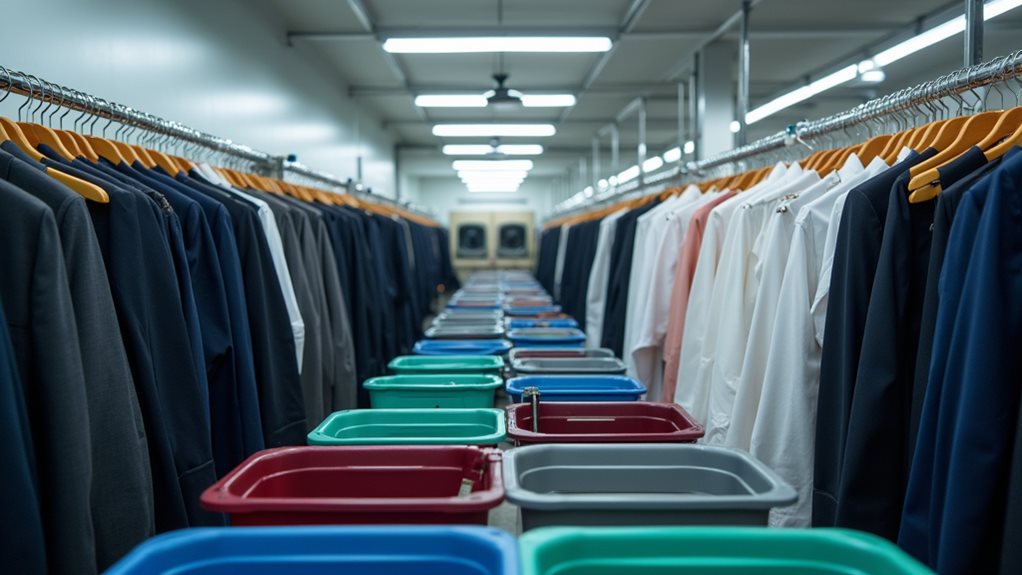
You’ll discover that your dry cleaning business serves two distinct customer worlds, where individual clients might drop off their favorite silk blouse once a week, while business accounts regularly deliver dozens of uniforms that keep your revenue stream flowing like clockwork.
The beauty of this industry lies in how frequently people need your services—most customers visit anywhere from once to four times monthly, creating that reliable income pattern every business owner dreams about 💰.
When you break down the numbers, you’re looking at individual visits ranging from $20 to $50, which means each loyal customer can contribute anywhere from $240 to $2,400 annually, depending on their lifestyle and cleaning needs.
Successful dry cleaners in affluent neighborhoods often command premium pricing due to their clientele’s willingness to pay for quality service and convenience.
Individual Vs Business Clients
How dramatically different your dry cleaning business’s revenue streams can become when you understand the distinct spending patterns between individual customers and business clients, something I learned firsthand when my neighbor’s uniform cleaning contract single-handedly doubled his monthly earnings.
While individual clients bring steady income averaging $1000-1200 annually with their $20-50 visits, business clients transform what your dry cleaning business makes through bulk contracts worth $240-2400 per customer yearly.
The individual vs business clients debate isn’t just about numbers—it’s about understanding completely different needs and priorities that’ll shape your success.
- Individual clients prioritize convenience and quality over everything else
- Business clients demand reliability and consistent bulk service capabilities
- Corporate contracts provide predictable monthly revenue streams
- Hospitality sectors require regular uniform and linen cleaning services
- Economic improvements boost demand from both customer segments considerably
Understanding that most Americans spend between $200 to $500 annually on professional garment care helps dry cleaning businesses recognize the revenue potential within their local pricing structures and target market demographics.
Visit Frequency Patterns
Understanding visit frequency patterns becomes absolutely essential when you’re trying to predict cash flow and build sustainable growth, because I’ve watched too many dry cleaning owners struggle with feast-or-famine cycles simply because they never mapped out when their customers actually show up.
Your typical customers will visit anywhere from 1 to 4 times monthly, and this variation dramatically affects your dry cleaning business revenue streams.
I’ve noticed that regular weekly visitors often become your bread-and-butter clients, spending $20-50 per visit and contributing that sweet $1000-1200 annually. The sporadic monthly customers, while less predictable, still represent solid income potential.
Smart owners track these visit frequency patterns religiously, adjusting staffing and inventory accordingly, because understanding when people need your services helps you anticipate those vital revenue peaks and valleys.
Implementing pickup and delivery services can significantly alter these frequency patterns by making it more convenient for customers to use your services regularly, potentially converting sporadic visitors into more frequent clients.
Annual Spending Ranges
Three distinct customer segments emerge when you analyze annual spending ranges in dry cleaning, and I’ve learned that recognizing these patterns early can mean the difference between struggling to pay rent and building a thriving business that supports your family.
Your light users spend $240-$600 annually, visiting once monthly with smaller orders.
Regular customers fall into the $600-$1,200 range, coming 2-3 times monthly for consistent needs.
Heavy users exceed $1,200 yearly, often business professionals requiring frequent service.
Understanding these annual spending ranges helps your dry cleaning business forecast revenue more accurately:
- Light users average $20-30 per visit with seasonal clothing items
- Regular customers spend $25-40 per visit consistently year-round
- Heavy users drop $40-60+ per visit, including specialty garments
- Business clients often represent your highest-value segment
- Location demographics heavily influence which segments dominate your customer base
Your heavy users may also include customers with curtain dry cleaning needs, where specialty items like drapes with pleats or delicate fabrics can cost $30-75 per panel.
Average Annual Revenue Benchmarks by Business Size and Location
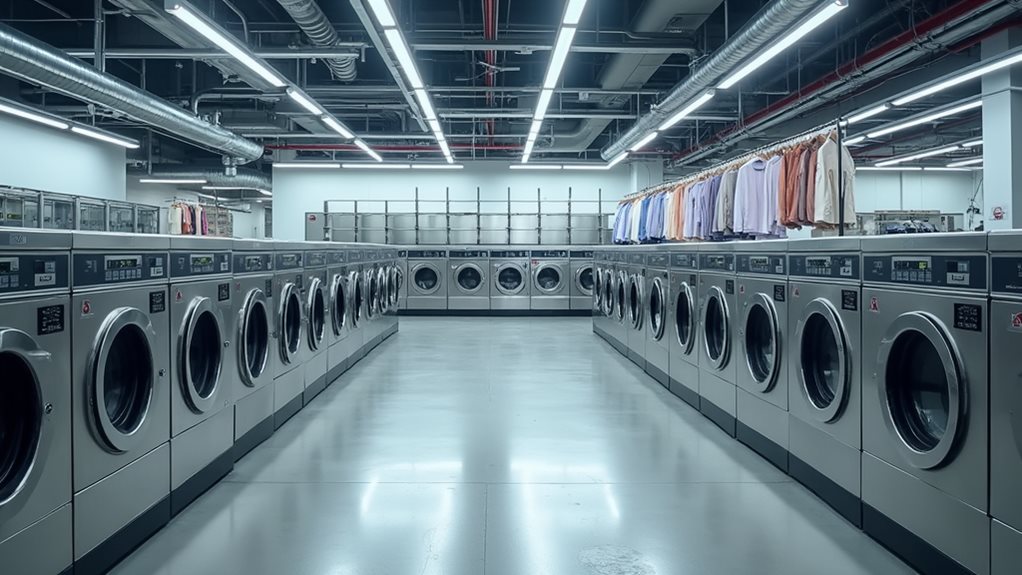
When you’re considering opening a dry cleaning business, your location will dramatically shape your earning potential, and honestly, the differences can be pretty shocking 💰.
You’ll find that small town operations typically pull in around $24,000 annually, which sounds modest until you compare it to urban locations that can reach $120,000, while those lucky enough to secure prime metropolitan spots might even hit $360,000 per year.
I remember being surprised when I first learned these numbers, because the gap between a small town cleaner and a high-end city operation can literally be the difference between scraping by and building genuine wealth.
These revenue ranges make sense when you consider that the dry cleaning industry generates approximately $8-10 billion annually in the United States alone, with thousands of establishments competing across various market segments.
Small Town Revenue Patterns
Although small town dry cleaning businesses face unique challenges that their urban counterparts rarely encounter, they’ve carved out sustainable niches that can surprise even seasoned business veterans with their resilience.
Your average revenue might hover around $24,000 annually—roughly $2,000 monthly—but don’t let those numbers discourage you. Small town dry cleaning businesses operate differently, and honestly, I’ve seen owners thrive with smart cost management 📊.
Here’s what you’ll typically encounter:
- Customer visits averaging 1-2 times monthly per person
- Spending ranges between $20-$50 per visit
- Lower overhead costs compared to urban locations
- Stronger customer loyalty and word-of-mouth referrals
- Revenue fluctuations tied to local economic conditions
Your success depends heavily on understanding your community’s needs and maintaining those precious personal relationships that big-city cleaners often miss. Many small town operators discover that offering specialty garment care alongside basic cleaning services can significantly boost their annual earnings beyond these baseline figures.
Urban Location Earnings
Since urban dry cleaning businesses operate in dramatically different surroundings than their small-town counterparts, you’ll find the revenue terrain shifts considerably—and honestly, the numbers might make your head spin in the best possible way.
Your dry cleaning business in an urban location can expect dramatically higher earning potential, with smaller operations typically generating around $120,000 annually compared to rural counterparts.
Medium-sized urban shops often achieve $240,000 to $360,000 yearly, benefiting from higher foot traffic and metropolitan demand.
The real magic happens with high-end urban locations targeting affluent clientele—these powerhouses can reach $1 million annually through premium pricing strategies.
Your urban location earnings depend heavily on positioning, with top performers potentially netting $180,000 in pure profit yearly.
These impressive revenue figures align with the industry standard profit margins of 15-25% that successful dry cleaning operations typically achieve.
Metropolitan Market Performance
In metropolitan markets, you’ll discover that high-end establishments routinely achieve $360,000+ annually, while your average urban dry cleaning business typically generates around $120,000 yearly.
The key difference? Customer demographics and spending patterns that’ll make your head spin with possibility.
Consider these metropolitan market advantages:
- Premium clientele willing to spend $1,000-$1,200 annually on dry cleaning services
- Higher population density creating consistent customer flow throughout the week
- Corporate partnerships and bulk contracts that stabilize revenue streams considerably
- Luxury garment care commanding premium pricing structures and specialized services
- Strategic locations near business districts maximizing convenience and repeat business
Your success depends entirely on understanding these market dynamics and positioning accordingly.
The industry’s shift toward eco-friendly cleaning technologies also presents metropolitan businesses with opportunities to differentiate through sustainable practices that appeal to environmentally conscious urban consumers.
Operating Expenses and Cost Structure Analysis
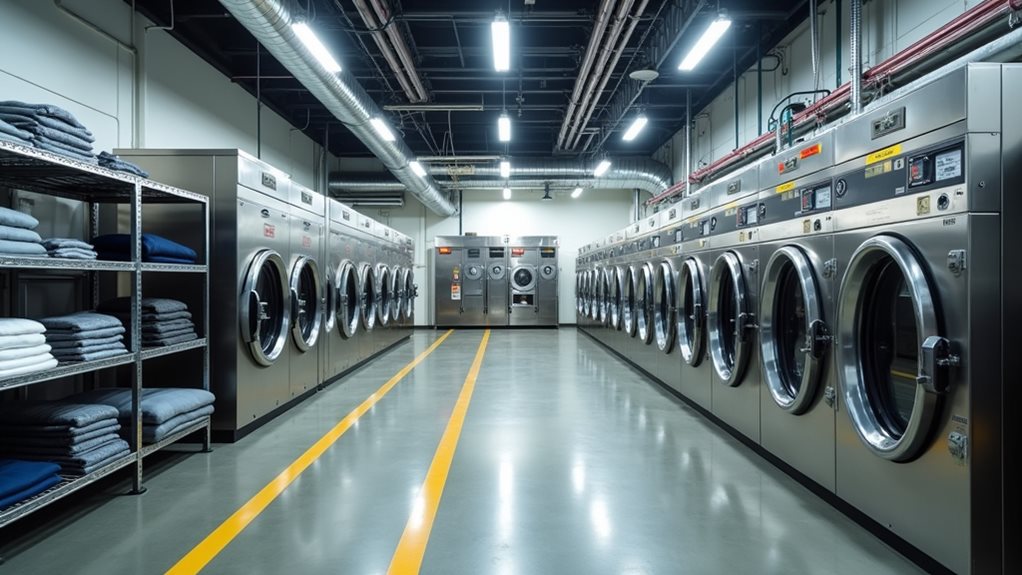
The brutal reality of running a dry cleaning business hit me like a wrinkled shirt when I first calculated my monthly operating expenses, and trust me, those numbers can make your head spin faster than a commercial washing machine.
You’re looking at chemical solvents, equipment maintenance, rent, staff wages, marketing costs, and utilities that’ll easily surpass $10,000 monthly for even a small operation.
Here’s the kicker though – while your profit margins might hover between 30-50% gross and 10-25% net, you’ll need to service roughly 2,000 pieces monthly just to break even.
The secret sauce? Smart cost management through vendor negotiations, utility control, and streamlined operations, because fluctuating demand and rising labor costs will test your financial stamina daily.
Your overhead costs including rent and equipment maintenance will directly impact whether you’ll land in that typical $40,000 to $70,000 annual earning range that most dry cleaning owners experience.
Profit Margins and Breakeven Points for Dry Cleaning Operations
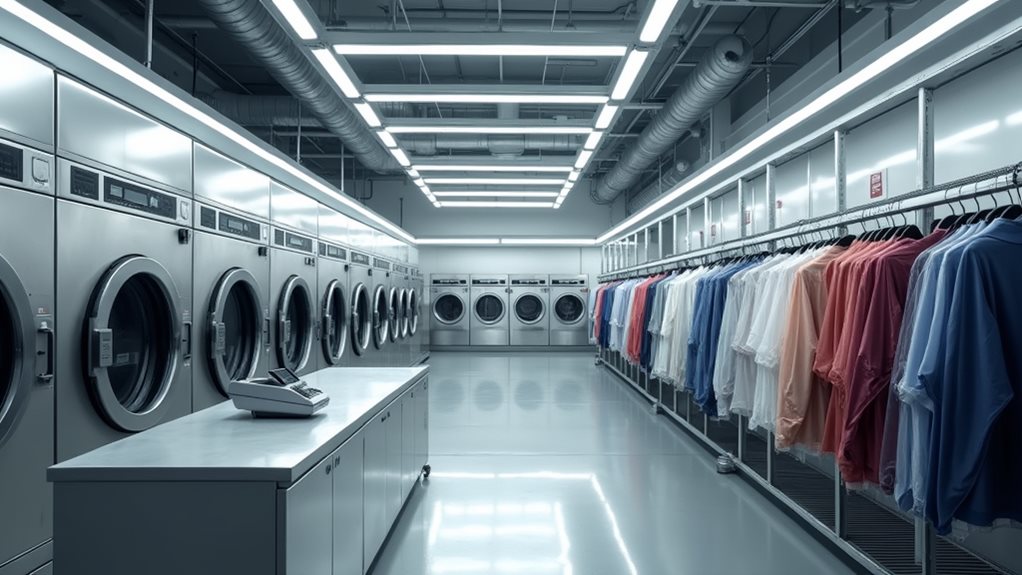
Numbers don’t lie, and when you’re staring at your first quarterly profit and loss statement, those brutal percentages will either make you do a happy dance or question every life choice that led you to the dry cleaning industry.
Understanding profit margins and breakeven points isn’t just accounting jargon—it’s your financial lifeline.
These numbers separate thriving dry cleaning businesses from those that fold faster than a wrinkled shirt.
Your gross margins will typically hover between 30% to 50%, while net margins settle around 10% to 25%.
That breakeven point? You’ll need roughly 2,000 pieces monthly to cover those stubborn $10,000 fixed expenses.
- Gross margins range from 30-50% in typical operations
- Net profit margins average 10-25% after all expenses
- Breakeven requires servicing approximately 2,000 pieces monthly
- Fixed expenses average around $10,000 per month
- Exceptional performers can achieve margins exceeding industry standards 📊
Key Factors That Impact Profitability and Revenue Growth
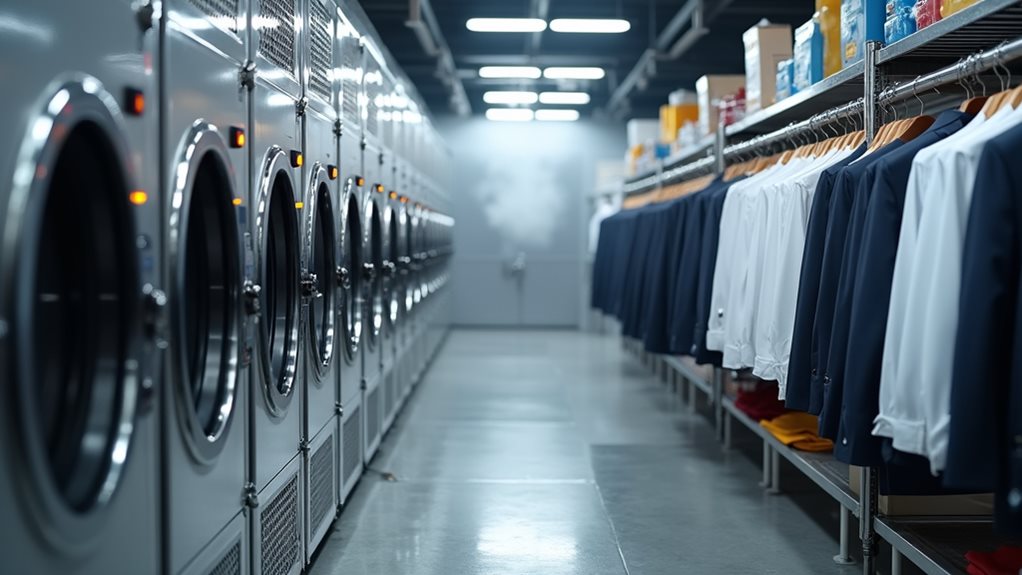
Beyond those baseline numbers lies a complex web of variables that’ll either propel your dry cleaning business toward six-figure success or keep you grinding through another month of barely breaking even.
Your location determines everything – I’ve seen identical operations where one thrives in a bustling business district while another struggles in a declining strip mall.
Customer loyalty becomes your lifeline when you’re competing against chains, and honestly, those relationships take years to build properly.
Economic downturns hit hard because dry cleaning isn’t exactly vital spending 😅.
Your profitability hinges on mastering cost control too – negotiating better supplier rates, optimizing utility usage, and streamlining operations.
Smart dry cleaning business owners obsess over these details because they’re the difference between surviving and actually making money.
Real-World Earnings Potential for Dry Cleaning Business Owners
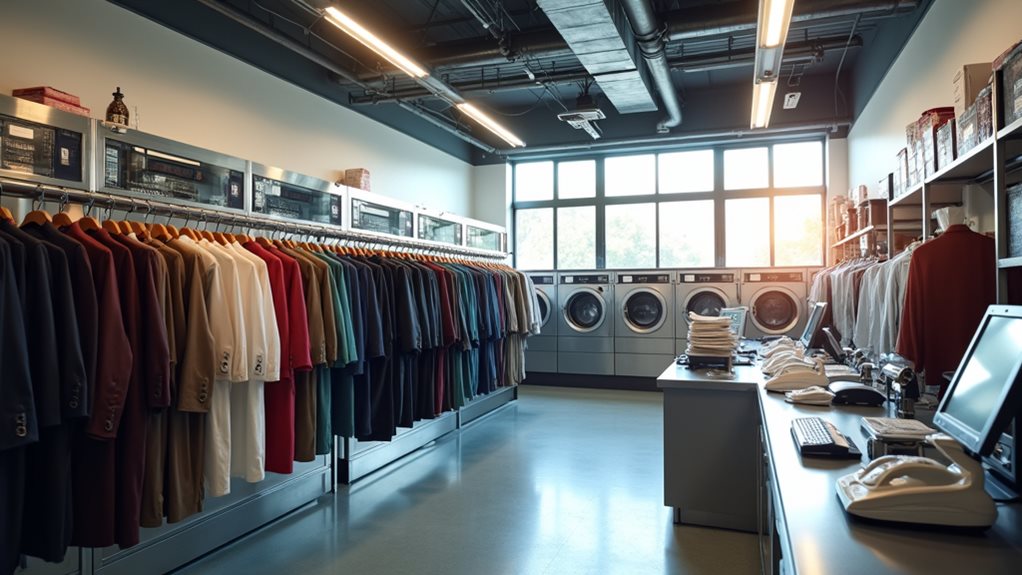
While those foundational factors set the stage, let’s plunge into what you can actually expect to earn as a dry cleaning business owner, because I’ve watched too many entrepreneurs get blindsided by unrealistic expectations.
Your dry cleaning business earnings will vary dramatically based on location and execution, with the average price of services playing a vital role in your bottom line.
Location and execution determine everything—your dry cleaning profits could range from barely surviving to exceptionally thriving based on these critical factors.
Here’s what real owners are actually making:
- Small town operations: $24,000-$36,000 annually ($2,000-$3,000 monthly)
- High-end metropolitan areas: Up to $360,000 yearly ($30,000 monthly)
- Exceptional performers: Around $180,000 annually ($15,000 monthly)
- Struggling businesses: As low as $7,200 yearly ($600 monthly)
- Industry average: Approximately $36,000 annual profit
These numbers aren’t theoretical—they’re pulled from actual business performance data.

